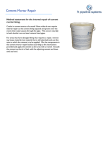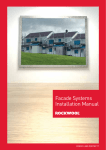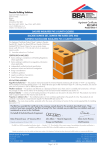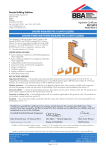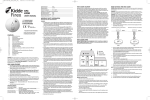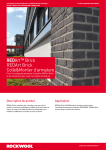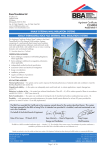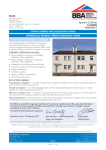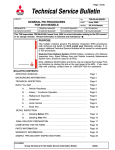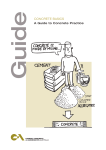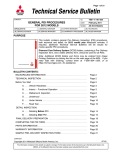Download Facade Systems Installation Manual
Transcript
Facade Systems Installation Manual Introduction Section 1 Preparing the substrate 01 Cleaning the substrate This installation manual is a comprehensive guide to using ROCKWOOL Facade systems; our complete external wall insulation solution. The following systems are covered by this manual: The surface should be thoroughly checked and prepared before any work commences. Walls should be stable, dry and free from dirt, dust, old peeling paint and other contaminants as these will reduce the adhesion of the board adhesive. The ideal method is to wash the entire wall using a pressure washer or mechanically (e.g. using a wire brush). If required, the facade should receive an application of ROCKWOOL Fungicidal Wash. n REDArt™ Silicone n REDArt™ Silicone + n REDArt™ Dash n REDArt™ Brick Effect n REDArt™ Granite n EcoRock® Contents 02 Evaluating the substrate Preparing the substrate............................................................................................................... 3 Installing the insulation............................................................................................................... 5 Base Coat and Reinforcing Mesh ............................................................................................... 9 Finishes REDArt™ Silicone, REDArt™ Silicone +, EcoRock® ................................................................. 11 REDArt™ Dash, ........................................................................................................................... 13 REDArt™ Brick Effect, ................................................................................................................ 14 The substrate must be inspected to identify potential problem areas such as (but not limited to) existing loose coatings or uneven surfaces. Where existing render coatings are present these should be checked for loose or blown areas via a hammer test. All identified areas must be removed and made level using a suitable levelling mortar, i.e. ROCKWOOL Anti-Crack Render. It is recommended that render coatings are removed around window and door jambs to expose the substrate and allow a secure bond. If present, old paint should be checked for stability by running a sharp tool across its surface and applying and removing adhesive tape. If the paint comes off in whole areas it should be completely removed and thoroughly cleaned until the substrate is exposed. Please ensure that you have an up-to-date specification from ROCKWOOL before undertaking any installation of our systems. All installation instructions should be read in conjunction with the relevant product technical data sheets and system certifications. Interested? For further information, contact the systems solutions team. Email: [email protected] Phone: 01656 868 445 2 03 Levelling the substrate ROCKWOOL Facade Systems will accommodate local deviations in the substrate of +/- 5mm. If needed, the substrate can be levelled by using a suitable levelling mortar, or thicker insulation boards. Remember that when levelling, longer mechanical fixings may be required to ensure the correct embedment depth is achieved. 3 Section 2 Installing the insulation 04 Starter track installation 06 Preparation of board adhesive The temperature must not be below 5°C on a falling thermometer or below 3°C on a rising thermometer (ensuring it rises above 5°C). Starter tracks should be fixed prior to installing the insulation boards. Starter tracks must not be fitted below the DPC line and must be a minimum of 150mm above ground level (unless specified otherwise). Starter tracks are to be fitted using ROCKWOOL Base Profile Fixing Screws at maximum 300mm centres. Packers should be used on uneven substrates. Adjoining lengths must be connected using ROCKWOOL Base Profile Connection Clips and levelled using a spirit level. ROCKWOOL Insulation Board Adhesive should be used in conjunction with ROCKWOOL systems. Use approximately 5.5 litres of cool, clean water for 25kg of dry substance. Leave for 10 minutes and then stir again before applying. The product is suitable for use for up to 3 hours. During use, mix the adhesive every 30 minutes.The adhesive can be applied covering the whole surface of the board or in a perimeter with dabs. The adhesive should cover not less than 40% of the board surface. At internal and external corners, the starter track should be cut and mitred ensuring the front drip section is not broken. Do not apply in poor weather conditions. 05 External fixtures and other preparation works Treated timber pattress blocks must be installed at the fixing points for all external fixtures including (but not limited to) washing lines, downpipes, and satellite dishes. Window sills must be extended to ensure that they oversail the ROCKWOOL Facade system by a minimum of 30mm. Boiler flues must be extended in accordance with current regulations by certified operatives. Any electrical cables that are to be hidden behind the insulation must be tested to ensure they will still perform effectively after the insulation slab has been installed. 07 Applying board adhesive to insulation The insulation surface must be cleaned of dust and loose material. a. Dual density slab 1200 x 600mm Ensure the board adhesive is applied to the rear face / softer side of the insulation. The outer face / harder side is labelled ‘This Side Up’. The board adhesive can be applied in two ways: n If no levelling is required, the adhesive should be applied using a full comb method. Apply the board adhesive to the insulation using a 10mm notched trowel. Leave ridges in the board adhesive and ensure the slab face is fully covered. It is important to ensure the mortar is pressed into the insulation to improve adhesion. n If localised levelling is required, the adhesive should be applied using the ribbon and dab method. It should be noted that when using the ribbon method, the maximum that can be added to the back of the board is 15mm. Any more than this and the specified fixing will not achieve the correct embedment depth. Apply a tight scratch coat to the perimeter of the insulation and also at the locations of the dabs to improve adhesion. Apply the board adhesive to the tight coat; place a band of adhesive 50mm wide to the perimeter and a minimum of 3 additional dabs across the centre. A minimum of 40% of the board face must be covered. Adhesive applied to the perimeter of the board must be applied in a uniform manner to ensure it does not extend into the board joints when fixed to the wall. b. ROCKWOOL Facade Lamella 1000 x 500mm Apply the board adhesive to the insulation using a 10mm notched trowel. Leave ridges in the board adhesive and ensure the face of the lamella is fully covered. It is important to ensure the mortar is pressed into the insulation to improve adhesion. 4 5 08 Fixing the insulation 10 Checking the level of the insulation boards Please note that during stages 8 and 9, the surface of the insulation should be checked for plumb, level and flushness using a long spirit level. Once the board adhesive has been applied, the insulation should be attached to the substrate at the required location. Push into place and adjust by tapping with a flat trowel. The board should be tightly butt-jointed to ensure no gaps are left. Any mortar that squeezes through the board joint should be removed to prevent cold bridging and potential cracking of the finished render. DO NOT attempt to correct the position of the insulation after it has been installed for a few minutes as this will break the adhesive bond. Install the insulation from the starter track and then work up the building Facade. Board joints should be installed with vertical staggered joints (brick bond). Board joints at corners should be staggered in a break bond format. DO NOT install boards less than 200mm in diameter width or height. 11 Sealing tape ROCKWOOL Sealing Tape must be installed at all junctions of the insulation and building components, i.e. window frames, door frames, window sills, etc. Sealing tape should also to be installed around all punctures through the system, such as boiler flues, pattresses, air brick extenders, etc. 09 Fixing insulation around openings At window and door openings the insulation should be cut to ensure that there is no vertical or horizontal board joint at the corner of the opening. The insulation board should be a minimum distance of 200mm from the corner of the opening to the insulation edge. Where the opening is to receive insulation to the reveal / jamb, the main insulation should oversail the reveal insulation. 6 12 Infilling gaps between insulation boards Gaps between insulation boards larger than 2mm should be filled using strips of ROCKWOOL insulation. Filling of the joints with mortar is not acceptable as this may cause cold bridging and cracking of the finish render. 7 Section 3 Base Coat and Reinforcing Mesh 13 Mechanical fixing 14 Preparation of base coat Masonry Holes should be drilled through the insulation into the substrate using the correct type of drill for the substrate. The embedment depth of the fixing is stated in the project specification. When drilling always drill 10mm deeper to ensure debris does not interfere with the fixing. Holes should be drilled in the pattern stated in the project specification. When using the 5 hole fixing pattern, these holes should be drilled 100 - 150mm diagonally inwards from the corners of the insulation boards. The fixing should be carefully inserted into the hole with the centre board hammered or screwed in (dependent on fixing). The fixing head should be flush with the insulation. Do not overdrive fixings as this indents the insulation. If a fixing is overdriven by more than 5mm, it is deemed unsuitable and should be removed and a new fixing installed adjacent to it. Sheathing boards The fixing is in two parts using a separate screw and washer. The screw length must be the insulation thickness + sheathing board thickness + 15mm. Insert the screw into the washer and drive it carefully into the sheathing board. The fixing head should be flush with the insulation. Fixings should not be overdriven as this will cause indentation of the insulation. Where this has occurred, and the fixing has been overdriven by more than 5mm, it is deemed to be unsuitable and should be removed and a new fixing installed adjacent to it. Please ensure the correct base coat is being used for the specified render finish. Rockwool systems utilise the following base coat mortars: n ROCKWOOL FS1 Mortar mixed with 5.5 litres of clean water n ROCKWOOL FS2 Mortar mixed with 5.0 litres of cool, clean water n ROCKWOOL Bedding Mortar mixed with 4.0 - 5.0 litres of cool, clean water Base coats should be properly prepared by thoroughly mixing a full bag with clean, cool water. Slowly pour the contents of the bag into a container with the correct amount of clean water stated above and stir thoroughly with a slow-speed drill until an even paste consistency is achieved. Leave for 10 minutes and then stir again before use. Do not add any more water. The product is suitable for use for up to 3 hours. During application, mix the mortar every 30 minutes. Additional water must NOT be added to the mortar once mixed. The base coat should not be applied within 48 hours of fixing the insulation boards. 15 Corner beads and stress patches Stress patches Stress patches must be a minimum size of 250mm x 500mm and installed at all corners of openings at 45°C. These should be installed with a thin layer of base coat ensuring the base coat is trowelled into the insulation surface. Stress patches must also be installed over any pattress blocks and at the point of any penetration through the system. These must be a minimum of 100mm larger than the feature and installed at 45°C. Corner beads and other associated products Corner beads should be installed using small dabs of base coat to all external corners of insulation slab. Adjust to ensure a good line and level. Other beads and trims, such as expansion joints, should be installed at the same time. When installing beads with no integral mesh it is advisable to run a 150mm strip of mesh over the leg to ensure correct coverage of the main reinforcing mesh is achieved. 8 9 Section 4 Finishes REDArt™ Silicone, REDArt™ Silicone +, EcoRock® 16 Checking the level of the insulation boards installing base coat and reinforcement mesh 17 Applying priming coat ROCKWOOL Facade Systems utilise the following primers: The temperature must not be below 5°C on a falling thermometer or below 3°C on a rising thermometer (ensuring it rises above 5°C). There must be no risk of frost within 48 hours of application. n n There are two methods of applying the base coat and reinforcement mesh. The surface of the insulation must be free from dust and loose particles. The surface of the base coat must be primed prior to the application of the finish coat to ensure optimum adhesion. Where coloured renders are used, the priming coat must be coloured to match. The priming coat must be used. Reinforcing mesh This must be applied whilst the base coat is still wet as detailed below. ROCKWOOL Universal Mesh must be installed evenly over the surface ensuring there are no waves or bumps. The reinforcing mesh should not be installed directly on to the surface of the insulation. ROCKWOOL Universal Mesh has two red bands that follow the first 100mm of either side of the mesh. The reinforcing mesh must have a minimum 100mm overlap at all vertical and horizontal joints and must cover the complete facade, including reveals at openings. Method 1, single coat The base coat is applied using a flat trowel at a depth of approximately 5mm ensuring it is pressed into the insulation surface to improve adhesion. Using a 10mm notched trowel, create ridges in the base coat removing any excess material. Gently press the reinforcing mesh into the base coat to secure its position. Whilst still wet, with a flat trowel draw the base coat through the mesh to ensure it is fully covered. The base coat should have a finished thickness of 5 to 6mm, be left smooth and level with no trowel lines and with the reinforcing mesh in the outer third. Do not use a sponge float. REDArt™ Silicone Primer EcoRock® Primer Leave the base coat to cure for a minimum of 48 hours prior to application of the priming coats (this may need extending in adverse weather). The primer can be applied using a brush or roller. It must be uniform and applied to the complete area. The primer must not be diluted as this deteriorates the bonding properties. 18 Preparation of top coat Leave the priming coat to dry for a minimum of 24 hours prior to the application of the REDArt™ Silicone, REDArt™ Silicone +, or EcoRock® Finish Render. It is important that the scaffold is cleaned and all site dust and rubbish is removed. Each elevation must be finished using material from the same production batch to ensure consistency of colour. Where different production batches are to be used, the material should be mixed together in a large tub. Gently mix each tub using a slow rotational mixer to disperse the aggregate. Method 2, two coats The base coat is applied using a flat trowel at a depth of approximately 5mm ensuring it is pressed into the insulation surface to improve adhesion. Using a 10mm notched trowel, create ridges in the base coat removing any excess material. Gently press the reinforcing mesh into the base coat to secure its position. After the first coat has set (typically 24 to 48 hours) apply a second tight coat ensuring the mesh is fully covered. The base coat should have a finished thickness of 6 to 8mm, be left smooth and level with no trowel lines and with the reinforcing mesh in the outer third. Do not use a sponge float. A tight 1mm layer of base coat MUST NOT be applied to the finished base to remove minor deviations as this will debond during curing. 10 11 Section 4 Finishes REDArt™ Dash Effect 19 Application of top coat 20 Preparation of dashing mortar Weather conditions must be closely monitored during the application of the dashing mortar. ROCKWOOL Dash Receiver should be properly prepared by thoroughly mixing a full bag of the specified colour with 4.5 to 5 litres of clean, cool water using a slow rotation drill with a suitable mixer. After achieving a homogenous mix, free from lumps, leave for 5 minutes and then mix again. Once prepared it should be used within 1 hour, mixing every 30 minutes. Weather conditions must be closely monitored as the top coat cures through the evaporation of moisture. The temperature must not be below 5°C on a falling thermometer or below 3°C on a rising thermometer (ensuring it rises above 5°C). There must be no risk of frost within 48 hours of application. The finish coat must be suitably protected against rain, strong winds and high exposure to the sun. Apply the ROCKWOOL top coat to the wall at a thickness equal to the grain size using either a steel trowel or plastic float. It is important that all operatives use the same trowel type. Ensure adequate coverage of the base coat is achieved and any excess material is removed. In order to avoid any visible lines, a sufficient number of operatives must be used to ensure that a wet on wet application is achieved with no breaks during the application. Additional water must NOT be added to the mortar once mixed. 21 Preparation of spar dashing aggregate Texture the top coat using a plastic float while the top coat is still wet. Ensuring constant and consistent pressure is applied, rub the float over the surface in a circular motion. During this process, excess material from the top coat will be removed. This must not be reused. Once a consistent and acceptable finish has been achieved, lightly rub the float over the surface in a figure of eight to remove any lines. Bags of spar dashing aggregate should be opened and emptied into a large self-draining tub. Wash the aggregate with cool, clean water to remove any dirt and dust and allow to dry. 22 Installing dashing mortar Weather conditions must be closely monitored during the application of the dashing mortar. The temperature must not be below 5°C on a falling thermometer or below 3°C on a rising thermometer (ensuring it rises above 5°C). There must be no risk of frost within 48 hours of application. Install ROCKWOOL Dash Receiver using a metal trowel to a thickness of 8mm with a level finish. 23 Installing spar dash aggregate Apply the aggregate to the ROCKWOOL Dash Receiver using a hawking trowel to the agreed coverage. For best results, flick the wrist with the trowel parallel to the render at the time the aggregate is released. Aggregate that falls and does not stick can be reused providing it is cleaned as set out in section 21. 12 13 Section 4 Finishes REDArt™ Brick Effect 24 Preparation of brick effect base coat 27 Installing brick effect finish coat Weather conditions must be closely monitored during the application of the mortar. ROCKWOOL Brick Effect Base Coat should be properly prepared by thoroughly mixing a full bag of the specified base coat with 4.4 to 5 litres of clean, cool water using a slow rotation drill with a suitable mixer. After achieving a homogenous mix, free from lumps, leave for 5 minutes and then mix again. Once prepared it should be used within 1 hour, mixing every 30 minutes. Weather conditions must be closely monitored during the application of the base coat. The temperature must not be below 5°C on a falling thermometer or below 3°C on a rising thermometer (ensuring it rises above 5°C). There must be no risk of frost within 48 hours of application. Apply ROCKWOOL Brick Effect Finish onto the stiffened ROCKWOOL Brick Effect Base Coat using a metal trowel to a thickness of 3 to 5mm with a level finish. Once applied, create texture using a brush or roller to achieve the desired effect. Additional water must NOT be added to the mortar once mixed. Once it has hardened it should be raked out to create the agreed brick effect pattern ensuring that no more than 1mm of the ROCKWOOL Brick Effect Base Coat is removed during this process. 25 Installing brick effect base coat Weather conditions must be closely monitored during the application of the base coat. The temperature must not be below 5°C on a falling thermometer or below 3°C on a rising thermometer (ensuring it rises above 5°C). There must be no risk of frost within 48 hours of application. Install ROCKWOOL Brick Effect Base Coat using a metal trowel to a thickness of 6 to 8mm with a level finish. Allow to stiffen before the application of the ROCKWOOL Brick Effect Finish. It must not be allowed to set prior to the application of the finish coat. Interested? For further information, contact the systems solutions team. Email: [email protected] Phone: 01656 868 445 Visit www.rockwool.co.uk to view the complete range of products and services. More information ROCKWOOL Limited reserves the right to alter or amend the specification of products without notice as our policy is one of constant improvement. ROCKWOOL is not liable for anything that may arise during installation of external wall insulation whilst following the instructions outlined in this guide. 26 Preparation of brick effect finish coat ROCKWOOL Brick Effect Finish should be properly prepared by thoroughly mixing a full bag of the specified finish coat with 4.4 to 5 litres of clean, cool water using a slow rotation drill with a suitable mixer. After achieving a homogenous mix, free from lumps, leave for 5 minutes and then mix again. Once prepared it should be used within 1 hour, mixing every 30 minutes. Additional water must NOT be added to the mortar once mixed. 14 15 Rockwool Limited Pencoed Bridgend CF35 6NY [email protected] www.rockwool.co.uk 16









